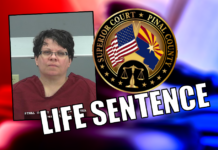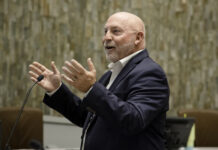Teachers and technology have been top selling points for the “Vote Yes on the Override” campaign in Maricopa.
City Councilman Vincent Manfredi is chairman of the campaign, and he, too, emphasizes the need for more teachers and tech. Raising taxes is not his modus operandi. Maricopa Unified School District’s proposed budget override would increase what taxpayers give the school in property taxes by $11 per month on $100,000 of assessed value.
The question goes to voters in the Nov. 8 General Election.
Supporting an override is not a knee-jerk reaction for Manfredi, despite having three daughters in MUSD schools. After the district failed six times to pass an override, he took a closer look.
“I dove deep into the budget,” he said.
Through his work with the MUSD Budget Committee, he became convinced the district had cut all the fat, was down to bare bones in administration – “Some of those people are doing two or three jobs,” he said – and classes were burgeoning.
“Twenty-five is OK in a class,” he said. “But some classrooms have 30 to 35 kids. That’s not good.”
[quote_box_right]Override proposal
Teachers
4 teachers at Butterfield Elementary School
4 teachers at Maricopa Elementary School
3 teachers at Pima Butte Elementary School
4 teachers at Saddleback Elementary School
2 teachers a Santa Cruz Elementary School
2 teachers at Santa Rosa Elementary School
2 teachers at Desert Wind Middle School
2 teachers at Maricopa Wells Middle School
9 teachers at Maricopa High School
2 elementary teachers on special assignment
2 instructional technology integration specialists
3 elementary counselors
1 elementary librarian
7 teachers for new alternative high school program
Tech
$334,600 for 490 laptop computers
$45,000 for additional tech staff
$38,000 for computer licensing
$30,910 for tech equipment/supplies
$30,000 for instructional technology professional development
$21,420 for 14 computer carts[/quote_box_right]
As proposed, the override would give the district funding for 47 more teachers and $500,000 in instructional technology. Seven of the teachers would be for a proposed “alternative” program at the high school.
Manfredi saw from previous override campaigns using the plea “It’s for the kids” doesn’t work in Maricopa.
To give the override campaign a better chance for success, Manfredi pushed the community impact of the vote. He also started the campaign earlier.
Because of the district’s history of failure on the issue, he knew changing minds was going to be imperative.
“I’ve been able to bring some staunch No’s over to Yes,” he said. “We’ve gotten these people that have voted no six times in a row to come out and help at events.
“We have to explain it differently than it used to be.”
This time, he is using some insight gained from his time on the city council as selling points. The link between a strong school district and a community’s economic development was part of that insight.
“A good school system is like a magnet,” Manfredi said. “Communities with good school have less crime and more economic development.”
He said it is a reflection of the community as a whole. If people looking for a home are drawn to Maricopa because of its three-time win as best suburb of Phoenix, one of the first things they look at is the school system.
With around 1,300 students being bused out of Maricopa every day to override-rich schools in Kyrene and Tempe, MUSD has difficult competition and fewer resources. Still when the state passed out letter grades, MUSD raised its rating from a C to a B.
“There are so many benefits to neighborhood schools,” Manfredi said. “It’s all about community pride.”
What MUSD budget override means to students
By Jamie Cluff
The Maricopa Unified School District Governing Board approved a 10-percent, seven-year override that will be on the Nov. 8 ballot, with the additional tax projected to be $132 per year on a home with an assessed value of $100,000. This override would allow the hiring of up to 47 K-12 teachers in 2017-18 to reduce the large class sizes and provide expanded academic programs for students. It would also provide more technology for instructional purposes.
The issue of money is not what matters in this override proposal. What’s at issue is students, the community and MUSD being able to provide the best education they can for their youth.
“Since it is a Saturday, and I am not at work, I can tell you that I think it should pass,” an MUSD staff member said at the March 19 Salsa Festival while a group of community members gave out information asking people to vote yes.
The students at Maricopa High School had a lot to say about the proposal once they learned how it affected the school. Shelby Hanks, a 2016 graduate, said, “Even though I won’t be here, I saw the effect this year of too many students coming in and not a lot of teachers to counteract it, so the class sizes were big… I definitely think it should pass.”
When asked, most students didn’t even know what the override was.
“I’m sad that we don’t have that now,” MHS incoming sophomore Alexius Karr said after she was informed of the details.
Carter Petty, an incoming senior at MHS, explained why he thinks the override should pass: “Large classes take away the interpersonal student-teacher relationship.”
“It will give new opportunities to Maricopa [Unified School District],” incoming senior Crystal Galavan said about the $500,000 that would go toward the instructional technologies.
The override would allow the district to hire 47 new teachers to spread around its nine schools. Butterfield, Maricopa, Pima Butte, Saddleback, Santa Rosa and Santa Cruz Elementary School would each get 2-4 teachers for class size reduction. Maricopa Wells and Desert Wind Middle School would get one teacher for class size reduction and one teacher for expanded academic programs. MHS, with 1,850 students, would receive five teachers for class size reduction and four teachers for expanded academic programs.
“I wish it had come sooner,” said Anna Cardinal, an incoming junior who, if the override passes, would experience the benefit her senior year.
Jamie Cluff is a student at Maricopa High School.
These stories appeared in the June issue of InMaricopa.

![3 things to know about the new city budget Vice Mayor Amber Liermann and Councilmember Eric Goettl review parts of the city's 2024 operational budget with Mayor Nancy Smith on April 24, 2024. [Monica D. Spencer]](https://www.inmaricopa.com/wp-content/uploads/2024/04/spencer-042424-preliminary-budget-meeting-web-218x150.jpg)






![MHS G.O.A.T. a ‘rookie sleeper’ in NFL draft Arizona Wildcats wide receiver Jacob Cowing speaks to the press after a practice Aug. 11, 2023. [Bryan Mordt]](https://www.inmaricopa.com/wp-content/uploads/2024/04/cowing-overlay-3-218x150.png)



![Alleged car thief released without charges Phoenix police stop a stolen vehicle on April 20, 2024. [Facebook]](https://www.inmaricopa.com/wp-content/uploads/2024/04/IMG_5040-218x150.jpg)

![3 things to know about the new city budget Vice Mayor Amber Liermann and Councilmember Eric Goettl review parts of the city's 2024 operational budget with Mayor Nancy Smith on April 24, 2024. [Monica D. Spencer]](https://www.inmaricopa.com/wp-content/uploads/2024/04/spencer-042424-preliminary-budget-meeting-web-100x70.jpg)


